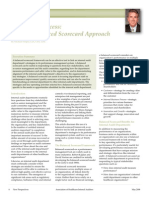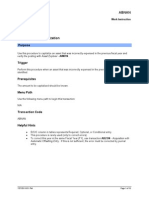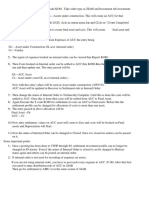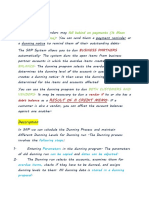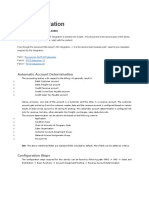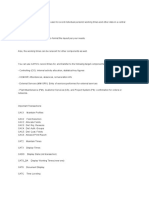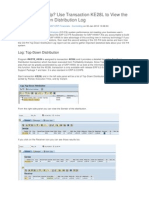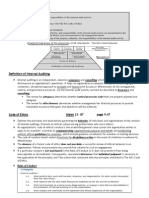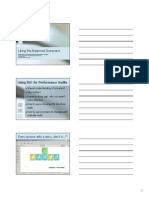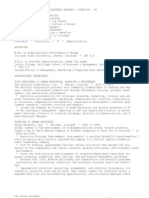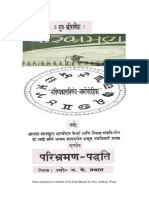Cost Center1
Cost Center1
Uploaded by
hossainmzCopyright:
Available Formats
Cost Center1
Cost Center1
Uploaded by
hossainmzOriginal Description:
Copyright
Available Formats
Share this document
Did you find this document useful?
Is this content inappropriate?
Copyright:
Available Formats
Cost Center1
Cost Center1
Uploaded by
hossainmzCopyright:
Available Formats
Overhead Cost Controlling
Objectives
To gain understanding of key business processes of SAP Overhead Cost
Management (OCM)
Understand the Organizational unit in Controlling
Determine the origin of posting in Cost center Accounting
SAP Overview
SAP Overhead Cost Management
Overhead Cost Management
The Overhead Cost Controlling component (CO-OM) helps you to plan, allocate, control,
and monitor overhead in your organization
By planning in overhead areas, you can develop standards, that allow you to control costs
and valuate internal activities.
Cost Centre Accounting
Cost Center Accounting analyzes where overhead occurs within the organization
Costs are assigned to the sub-areas of the organization where they originated.
SAP offers a wide variety of methods for allocating posted amounts and
quantities.
Internal Order Accounting
Internal Orders collect and analyze costs based on individual internal jobs.
SAP can monitor and automatically check budgets assigned to each job.
OCM Processes
SAP Overhead Cost Management
OCM Process Overview
Planning Master
Data
Cost Centre
Accounting
Actual
Posting
Period End
Closing
Reporting
Controlling
Planning Master
Data
Actual
Posting
Period End
Closing
Reporting
OCM Processes
Planning
preparation
Cost Centre
Planning
Internal Order
Planning
Plan cost
distribution
Plan cost
assessment
Plan indirect
activity allocation
Plan settlement of
overhead cost
orders
Reposting
Actual Cost
distribution
Actual Cost
Assessment
Cost Splitting
Calculate Actual
Activity Prices
Settlement of
Overhead Orders
Manual Cost
Allocation
FICO
Reconciliation
Cost Element
Cost Centre
Activity Type
Resource
Statistical Key
Figures
Internal order
Groups
Manual entries
SKF entry
Direct activity
allocation
Indirect activity
allocation
Order budget
Master Data
SAP Overhead Cost Management
Organizational Units & Master Data
A1 Ltd
9200
A Ltd
9100
HQ
1000
Cost Centers
Purchasing
13
Gen
Services
14
Company Codes
Orders Cost Objects
Sales and
Marketing
15
R & T
16
Other Cost Objects
Operating Concern
Controlling Area
A Grp Operating
Concern (9100)
A Grp Controlling
Area (1000)
Ethylene
Propylene
Pharma Polyolefins Power
Teleco
mmuni
cation
Inform
ation
techno
logy
Corporate
common
Profit Centers
Cost Element
Description
A cost element classifies the organization's valuated
consumption of production factors within a controlling area
Primary Element - costs that originate outside the company;
relate directly to the income statement in FI and must be
included in the FI Chart of Accounts
Secondary Element - costs that result from internal
allocation activities; NO relation to G/L accounts in FI. These
accounts are exclusively for cost accounting and are only
maintained in CO
Financial
Accounting
General Ledger
Accounts Payable
Accounts Receivable
Fixed Assets
Treasury
Controlling
Cost Centre Accounting
Internal Orders
Product Costing
Profitability Analysis
Cost Element vs GL Account
C
h
a
r
t
o
f
A
c
c
o
u
n
t
s
Balance
Sheet
Accounts
Adjustment
Accounts
C
o
s
t
E
l
e
m
e
n
t
s
Secondary
Cost
Elements
Income
Statement
Accounts
Primary
Cost
Elements
Cost Centre
Description
Organizational unit within a controlling area that represents a
defined location of cost incurrence. The definition can be
based on:
Functional requirements
Allocation criteria
Physical location
Responsibility for costs
Defines the smallest area of responsibility within the
company that causes and influences costs; the lowest level
to which you can meaningfully assign direct and indirect
costs
Cost Centre Standard Hierarchy
xx01 - Production
xx02 - Maintenance
xx03 - Utilities
xx04 Engineering & Projects
xx05 Quality Assurance
xx06 Production Planning
xx07 Production Handling
xx08 Warehousing & Storage
xx09 Executive Office
xx10 - Finance
xx11 Human Resources
xx12 Information Technology
xx13 - Purchasing
xx14 General Services
xx15 Safety & Security
xx16 Sales & Marketing
xx17 Research & Technology
xx18 Company General
A group
Standard
Hierarchy
A Ltd
9100
A1 Ltd
9200
A11 Ltd
9300
A111 Ltd
9400
9101000 Production Common
9101011 EG- 1 Plant
9110000 Finance
9111000 Human Resources
9111001 Housing Services
9111002 Training Centre
Functional Area Company Enterprise Cost Center
Activity Type
Description
Unit in a controlling area that classifies the activities performed in a cost
centre, e.g. maintenance hours for a maintenance cost centre
Used in activity allocation process
Statistical Key Figure
Description
Used to track quantities and values for various operating activities
Designed to be used in reporting and analysis
Used to assist in the allocation of costs throughout the OCM environment
Internal Order
Description
Used to plan, collect and settle the costs of internal jobs and tasks.
Internal orders are categorized as either:
Orders used purely to monitor objects within Cost Accounting (such as
advertising, training, or trade fair orders) and
Productive orders that are value-added, that is, orders that can be capitalized
(such as in-house construction of an assembly line).
Groups
Description
OCM master data can be grouped together, for example
Cost Centre Groups
Cost Element Groups
Activity Type Groups
Statistical Key Figure groups
Internal Order Groups
Master data groups are used in reporting, planning, allocation, etc.
You can divide complex groups into manageable sections by separating them into
sub-groups
You can create and maintain sub-groups separately and then combine them in
larger groups
Planning
SAP Overhead Cost Management
Planning preparation
Cost center planning
Cost Element Planning
Cost Element Planning Cost Element Planning
Year 2001
Periods 1 to 12
Cost center 30100 FI/CO consulting
Cost element Name
Salaries
Travel costs
1
1
Version Planned costs
Cost center Senior
consulting
Cost center
FI/CO
consulting
Junior
consulting
Planned costs on the cost
center
900000
500000
430000
474100
Plan cost Distribution
Company General
Materials 100
Staff Salaries 200
Rent & Rates
Light & Heating
Vehicles
Repairs
Travelling 20
Hotels 30
Total 0
Administration
Materials 60
Staff Salaries 120
Rent & Rates
Light & Heating
Vehicles
Repairs
Travelling 12
Hotels 18
Total 210
Production Support
Materials 40
Staff Salaries 80
Rent & Rates
Light & Heating
Vehicles
Repairs
Travelling 8
Hotels 12
Total 140
Allocation through original cost element
Plan Cost Assessment
Company General
Materials 100
Staff Salaries 200
Rent & Rates
Light & Heating
Vehicles
Repairs
Travelling 20
Hotels 30
Company General Costs -350
Total 0
Administration
Materials
Staff Salaries
Rent & Rates
Light & Heating
Vehicles
Repairs
Travelling
Hotels
Company General Costs 210
Total 210
Production Support
Materials
Staff Salaries
Rent & Rates
Light & Heating
Vehicles
Repairs
Travelling
Hotels
Company General Costs 140
Total 140
Allocation through secondary cost element
Actual Posting
SAP Overhead Cost Management
Manual Entries
Description
Actual cost entry enables you to monitor and trace costs incurred by your
company as they arise. This allows you to identify variances quickly and
take appropriate action to deal with them.
Actual cost entry involves transferring the primary costs recorded in
Financial Accounting (FI) to the Controlling (CO) application component.
In the CO component, this transfer occurs real-time from the components
FI, MM, and AM, whereby a cost accounting object is recorded during
account assignment
Process
Incorporated into other processes, e.g. FI Journal Entry, Goods Issue, etc
Manual Entries
Primary postings include the following transactions
Payroll
Material Usage
Travel
Goods Receipt / Invoice
Journal entry
Depreciation
Statistical Key Figure Entry
Statistical Key Figures required for reporting and allocations may be
entered into the system during the month or at month-end
They are recorded with a Controlling document number
Statistical Key Figures may also be transferred from Logistics Information
System (LIS)
Direct Activity Allocation
Description
Direct activity allocation involves the measuring, recording, and allocating
of business services performed
Activity types are used as the cost drivers
Activity allocation occurs, for example, when business transactions are
confirmed or when posting activity quantities to accounts, eg Plant
Maintenance Hour, Production Hours, Utilities, etc
The system multiplies the activity produced by the price of the activity
type.
Activity types are planned using prices set manually or using SAPs price
calculation
Indirect Activity Allocation
Description
Indirect Activity Allocation is a method of allocating actual and plan costs
using activity quantities as the basis. It is extremely beneficial when
calculating the activity quantities on the sender involves too much time or
expense. The value can be calculated inversely based on the activity
quantities actually consumed or planned on the receivers
Internal Order Budgets
Description
The budget is the approved cost limit for an internal order
The budget is the limit set by management for internal order costs over a
certain period of time
Budgets have the following components
Original Budget
Supplements
Returns
Transfers
Period End Closing
SAP Overhead Cost Management
Reposting
You can repost primary costs manually using transaction-based reposting,
whereby the original cost element is always retained. This function is
designed mainly to adjust posting errors.
You should always adjust posting errors in the application component
where they occurred. This ensures that FI and CO are always reconciled
You can only adjust posting errors involving one cost accounting object (a
cost center or internal order for example) using a transaction-based
reposting in Controlling (CO).
Allocations - Description
Two types of allocations:
Distribution
The following information is passed on to the receivers:
The original, primary, cost element is retained.
Sender and receiver information is documented with line items in the
CO document
Assessment
The following information is passed on to the receivers:
The original cost elements are grouped together into assessment cost
elements (secondary cost elements). The original cost elements are
not displayed on the receivers.
Sender and receiver information is displayed in the CO document
Distribution
Company General
Materials 100
Staff Salaries 200
Rent & Rates
Light & Heating
Vehicles
Repairs
Travelling 20
Hotels 30
Total 0
Administration
Materials 60
Staff Salaries 120
Rent & Rates
Light & Heating
Vehicles
Repairs
Travelling 12
Hotels 18
Total 210
Production Support
Materials 40
Staff Salaries 80
Rent & Rates
Light & Heating
Vehicles
Repairs
Travelling 8
Hotels 12
Total 140
Allocation through original cost element
Assessment
Company General
Materials 100
Staff Salaries 200
Rent & Rates
Light & Heating
Vehicles
Repairs
Travelling 20
Hotels 30
Company General Costs -350
Total 0
Administration
Materials
Staff Salaries
Rent & Rates
Light & Heating
Vehicles
Repairs
Travelling
Hotels
Company General Costs 210
Total 210
Production Support
Materials
Staff Salaries
Rent & Rates
Light & Heating
Vehicles
Repairs
Travelling
Hotels
Company General Costs 140
Total 140
Allocation through secondary cost element
Cost Splitting
Actual cost splitting makes it possible to divide costs into fixed and
variable portions
The actual costs are split in two stages:
In the first splitting step, the system distributes actual costs by cost
element to the activity types based on the target costs or target
quantities
In the second splitting step, the actual costs are distributed on the
activity types according to splitting rules. If you have not defined any
splitting rules for a cost center, the system splits actual costs based on
the equivalence numbers for the activity types.
It is only in this way that you can compare the actual costs with the target
costs of the activity types and display the variances by activity type.
Calculate Actual Activity Prices
During actual price calculation, the system calculates iterative prices for
activity types or business processes based on actual costs and actual
activities. The calculation takes into account all activity exchanges
between cost centres or business processes.
Price calculation, which you can carry out during planning, is based on
planned costs and activity. The resulting prices are used to valuate actual
activity.
After running actual price calculation, you can choose to revalue actual
activity at actual prices. This revaluates the activity using the difference
between plan and actual prices. By revaluing the actual activity with
actual prices, you can fully balance sender cost centres and sender
business processes.
Settlement of Overhead Cost Orders
Some or all of the plan and actual costs incurred on an object are
allocated to one or more receivers.
System automatically generates offsetting entries to credit the sender
object. The debit postings assigned to a sender object remain in place
even after settlement to a receiver
Two types:
Periodic Every period
Full After completion
Two methods:
Individual
By individual sender object
Allows to analyze in greater detail
Collective
Processes a large number of sender objects
Used during period-end closing activities
Fixed Asset
Settlement of Overhead Cost Orders
Overhead Cost Order
Materials 100
Staff Salaries 200
Rent & Rates
Vehicles
Repairs
Travelling 20
Hotels 30
Company General Costs -150
Capitalisation -200
Total 0
Cost Object B
Materials
Staff Salaries
Rent & Rates
Light & Heating
Vehicles
Repairs
Travelling
Hotels
Company General Costs 150
Total 150
Allocation through original cost account
or settlement cost element
Manual Cost Allocation
Manual cost allocation involves posting secondary costs manually. The
system credits a sender object (for example, a cost center) and debits a
receiver object (for example, an order)
You can use manual allocation to:
Avoid the need for complicated Customizing settings for simple
allocations
Manually transfer external data
Make simple adjustments to incorrect secondary postings.
FICO Reconciliation
The reconciliation ledger is a tool used to portray transaction figures in
Controlling in a summarized form
It provides reports with which you can monitor the CO/FI reconciliation for
each account
It can determine and display value flows that were posted in CO across
company codes and functional areas
Each company code in FI represents an independent accounting unit for
which a balance sheet must be created. Data flows between company
codes must be posted separately so that no information is lost. These
boundaries are not relevant for Controlling (CO).
You can use reconciliation postings to transfer cross-company code, or
cross-functional area postings made in CO that are relevant to FI, and to
automatically create reconciliation postings there
Month/Year end Closing - Process Map(1/2)
SAP Enabled
Processes
Electronic
Processes
SAP Job Role
Adjust
Inventory *
GL Doc. entry
9
Review & correct
billing errors
3
Release the
payroll
-5
Ensure payroll
Are posted
GL Inquiry
4
Ensure settlement
& depreciation
Are posted
Run Depreciation
Close the period
for AP & AR
Close Posting
Period
Enter journal
voucher *
GL Doc. entry
8 10 11
Close the period
for MM
Close Posting
Period
7
AP Disbursement
-1
Cash Out
-2
Fixed Asset
WBS Settlement
-6
Fixed Asset
Run Depreciation
-13
Send the monthly
Schedule manager
Logistics
1
Acknowledge
Schedule manager
2
Treasury
activities
Treasury
6
Simultaneous
Costing *
Logistics
5
Month/Year end Closing - Process Map(2/2)
SAP Enabled
Processes
Electronic
Processes
SAP Job Role
Execute
Assessment
Cycle
Allocations
21
Run the
Reconciliation
Ledger
Rec. CO with FI
22
Final Close
Of GL
Close Posting
Period
23
Generated
financial reports
GL Reporting
24
Temporally
Close GL
Close Posting
Period
17
End
Run the foreign
Currency valuation *
GL Periodic
Processing
Complete the
electronic bank
reconciliation *
Carry
forward
balances *
Periodic Pro.
15 16
25
Generate a
Preliminary
financial report
GL Reporting
18
Update materials
prices *
Pricing
14
Determine the
Lowest value
Principle *
Pricing
13
Product Costing *
Logistics
Material Ledger/
Actual Costing *
Logistics
19 20
Close the
Period for FA
Close Posting
Period
12
Reporting
SAP Overhead Cost Management
OCM Reporting
Comprehensive, flexible information system to analyze cost flows
Carry out standard recurring evaluations
Construct special reports for unique situations
Analyze all costs online and trace them right back to the original
document
Execute all reports available online in background runs as well (helpful for
large amounts of data)
For hierarchically grouped objects, such as cost centers, you can create
separate reports for all hierarchy nodes and individual objects, or you can
create all the relevant reports in a single selection run through the
database
The second option allows you to navigate within a hierarchy. This enables
particularly flexible monitoring of cost center areas
OCM Reporting Menu Path
OCM Sample Report Selection Criteria
You might also like
- Universal Parallel Accounting: Scope Information: SymptomDocument29 pagesUniversal Parallel Accounting: Scope Information: Symptomdgz5qm8kcwNo ratings yet
- IA BalancedScorecard & SWOTDocument6 pagesIA BalancedScorecard & SWOThossainmz100% (1)
- 03 WQuest 2 Progress Test U5-6Document3 pages03 WQuest 2 Progress Test U5-6Magdalena Quiroga100% (2)
- Visa Consulting and AnalyticsDocument20 pagesVisa Consulting and AnalyticsKristen NguyenNo ratings yet
- Dunning, Dunning Procedure in SAPDocument3 pagesDunning, Dunning Procedure in SAPmr_relyNo ratings yet
- SAP Foreign Currency Revaluation: FAS 52 and GAAP RequirementsFrom EverandSAP Foreign Currency Revaluation: FAS 52 and GAAP RequirementsNo ratings yet
- 06-03 GRC Training - Risk OwnersDocument35 pages06-03 GRC Training - Risk OwnershossainmzNo ratings yet
- Magazine Memorex Intercom 3Document12 pagesMagazine Memorex Intercom 3Bill Franklin100% (1)
- Overhead Cost ControllingDocument53 pagesOverhead Cost ControllingFelix SetiawanNo ratings yet
- Result ANADocument15 pagesResult ANAVinod Mehara MNo ratings yet
- Interest Configuration & Processing Manuual SAP 4.7Document5 pagesInterest Configuration & Processing Manuual SAP 4.7ksandeep_coolNo ratings yet
- Unit 3: Cost Element AccountingDocument9 pagesUnit 3: Cost Element AccountingneppoanandNo ratings yet
- SAP Controlling and COST Center Accounting (CO-CCA)Document17 pagesSAP Controlling and COST Center Accounting (CO-CCA)Ancuţa CatrinoiuNo ratings yet
- Auc Settlement To Main AssetDocument11 pagesAuc Settlement To Main AssetSwetha ReddyNo ratings yet
- Sap Tax Jurisdiction CodeDocument1 pageSap Tax Jurisdiction CodeNaseer Sap100% (2)
- ABNAN PostCapDocument10 pagesABNAN PostCapmagnomagno1No ratings yet
- Difference Between Activity Types and SKFDocument15 pagesDifference Between Activity Types and SKFSATYANARAYANA MOTAMARRINo ratings yet
- Results Analysis IAS EDocument22 pagesResults Analysis IAS Efazal509acd100% (1)
- Closing CockpitDocument22 pagesClosing CockpitDeepak TolaniNo ratings yet
- Cost CentersDocument44 pagesCost CentersPallaviNo ratings yet
- Collection ManagementDocument34 pagesCollection ManagementRaju50% (2)
- Asset Creation Via Internal OrderDocument1 pageAsset Creation Via Internal OrderPritpal Singh SNo ratings yet
- CO - Internal OrdersDocument7 pagesCO - Internal OrdersVishal YadavNo ratings yet
- Dunning Process For VendorDocument5 pagesDunning Process For VendorKancheti Bhanu PrasadNo ratings yet
- Reversing A Depreciation Run in Asset Accountin1Document2 pagesReversing A Depreciation Run in Asset Accountin1Neelesh KumarNo ratings yet
- Controlling 2Document4 pagesControlling 2yewalesudarshanNo ratings yet
- 1 DmeeDocument5 pages1 DmeeSubhas GuhaNo ratings yet
- FI - SD IntegrationDocument13 pagesFI - SD IntegrationchonchalNo ratings yet
- Correspondence in SAPDocument15 pagesCorrespondence in SAPshamshu zamanNo ratings yet
- Check Enter Company Code Global Parameters in Sap PDFDocument7 pagesCheck Enter Company Code Global Parameters in Sap PDFAMIT AMBRENo ratings yet
- Sap Fico SupportDocument6 pagesSap Fico Supportanand chawanNo ratings yet
- Work in Process Calculation - For ProjectsDocument6 pagesWork in Process Calculation - For ProjectsgildlreiNo ratings yet
- Cats IntrviewDocument4 pagesCats IntrviewmadanaganeshNo ratings yet
- Bad Debt ConfigrationDocument4 pagesBad Debt Configrationsudershan9No ratings yet
- SAP User Guide Accrual DeferalDocument48 pagesSAP User Guide Accrual DeferalwiwNo ratings yet
- SAP - Cost Center Accounting PDFDocument3 pagesSAP - Cost Center Accounting PDFpavan8412No ratings yet
- Tax Deducted at SourceDocument23 pagesTax Deducted at SourcePrathamesh Parker100% (1)
- Basics of Standard Costing - Understanding The Cost Component Structure-Part 3Document23 pagesBasics of Standard Costing - Understanding The Cost Component Structure-Part 3Kauam SantosNo ratings yet
- Controlling ExercisesDocument55 pagesControlling ExercisesJyotiraditya BanerjeeNo ratings yet
- Closing - Step - V1 - 20120813 - 1Document32 pagesClosing - Step - V1 - 20120813 - 1Patris SutrisnoNo ratings yet
- Profit Center ProcessDocument21 pagesProfit Center Processjiljil1980No ratings yet
- ZBRS Flow Version 1.0Document13 pagesZBRS Flow Version 1.0Kaladhar Guntur100% (1)
- Top Down DistributionDocument2 pagesTop Down DistributionJuluri Syam MaheshNo ratings yet
- Sap Fico DemoDocument13 pagesSap Fico DemokprakashmmNo ratings yet
- Multiple Valuation Approach - TP-S4HANA, On-Premise REL-19.07.2021Document10 pagesMultiple Valuation Approach - TP-S4HANA, On-Premise REL-19.07.2021Parvati sbNo ratings yet
- How To Create and Configure DME File: Skip To End of MetadataDocument3 pagesHow To Create and Configure DME File: Skip To End of Metadatasrinivas kalakuntlaNo ratings yet
- 4 8 - Validation and SubstitutionDocument32 pages4 8 - Validation and SubstitutionKalyan Chowdary100% (1)
- Non Leading Ledger Helps in Parallel AccountingDocument6 pagesNon Leading Ledger Helps in Parallel AccountingmonaNo ratings yet
- SAP GL Configuration Document - FI Implemenation StepsDocument5 pagesSAP GL Configuration Document - FI Implemenation StepsTharaka HettiarachchiNo ratings yet
- SAP DunningDocument13 pagesSAP DunningFarhad012No ratings yet
- Ch06 The Production ProcessDocument75 pagesCh06 The Production ProcessTommyutomowijaya50% (2)
- Target Vs Plan Cost Production OrderDocument2 pagesTarget Vs Plan Cost Production Order83pankajNo ratings yet
- Asset Configuration SAP FICODocument23 pagesAsset Configuration SAP FICOJagjit97% (29)
- Master Data Mass MaintenanceDocument12 pagesMaster Data Mass MaintenancePaul AlcosNo ratings yet
- Period Closing in Sap Ecc6Document14 pagesPeriod Closing in Sap Ecc6Roohi AjmeraNo ratings yet
- Cash Management Group & Planning LevelDocument4 pagesCash Management Group & Planning LevelUtkarsh DhamechaNo ratings yet
- Indirect Activity Allocation May 2013Document16 pagesIndirect Activity Allocation May 2013Naveen KumarNo ratings yet
- CONTROLLING AREA - OKKP SettingsDocument7 pagesCONTROLLING AREA - OKKP SettingsMohammed Nawaz ShariffNo ratings yet
- Assets Capitalization Routing Through CWIP or AuC With IODocument3 pagesAssets Capitalization Routing Through CWIP or AuC With IORavindra Jain100% (2)
- Manage Your SAP Projects with SAP Activate: Implementing SAP S/4HANAFrom EverandManage Your SAP Projects with SAP Activate: Implementing SAP S/4HANANo ratings yet
- Stock ControlDocument8 pagesStock ControlhossainmzNo ratings yet
- Cls01 ExcelDocument30 pagesCls01 ExcelhossainmzNo ratings yet
- Definition of Internal AuditingDocument10 pagesDefinition of Internal AuditinghossainmzNo ratings yet
- Activity Monitoring OrderDocument5 pagesActivity Monitoring OrderhossainmzNo ratings yet
- GRC Training RiskODocument151 pagesGRC Training RiskOhossainmzNo ratings yet
- Using The Balanced Scorecard: Using BSC For Performance AuditsDocument11 pagesUsing The Balanced Scorecard: Using BSC For Performance AuditshossainmzNo ratings yet
- Balance Scorecard Internal Audit1Document10 pagesBalance Scorecard Internal Audit1hossainmz100% (1)
- Bank Reconciliation Best PracticesDocument3 pagesBank Reconciliation Best Practiceshossainmz100% (2)
- GRC SOD Analysis StepsDocument9 pagesGRC SOD Analysis Stepshossainmz100% (1)
- GRC Guide NoteDocument4 pagesGRC Guide NotehossainmzNo ratings yet
- Job Application Form: Concern Worldwide BangladeshDocument6 pagesJob Application Form: Concern Worldwide Bangladeshhossainmz100% (1)
- GRC Training - TerminologyDocument13 pagesGRC Training - Terminologyhossainmz0% (1)
- Concern Worldwide & BracDocument4 pagesConcern Worldwide & BrachossainmzNo ratings yet
- Ob Description Job Description Job Descri: Job Title: Country Financial Controller Scope of ResponsibilitiesDocument4 pagesOb Description Job Description Job Descri: Job Title: Country Financial Controller Scope of ResponsibilitieshossainmzNo ratings yet
- Rights Issue Calculations MethodsDocument6 pagesRights Issue Calculations MethodshossainmzNo ratings yet
- Fiona Aish, Collins Get Ready For Ielts Writing (Collins English For Exams)Document135 pagesFiona Aish, Collins Get Ready For Ielts Writing (Collins English For Exams)Inderdeep Singh80% (5)
- VETASSESS General Occupation ListDocument17 pagesVETASSESS General Occupation ListhossainmzNo ratings yet
- VAT - Exemption-199 of 2010Document19 pagesVAT - Exemption-199 of 2010hossainmzNo ratings yet
- Cisa Syllabus CBLDocument4 pagesCisa Syllabus CBLhossainmz100% (1)
- ProgaponDocument4 pagesProgaponhossainmzNo ratings yet
- VAT On Advertising CompanyDocument1 pageVAT On Advertising CompanyhossainmzNo ratings yet
- Amnaya Sutra (English)Document458 pagesAmnaya Sutra (English)Assam Bhakti SagarNo ratings yet
- Proposal Form NagDocument1 pageProposal Form Nagnitheesh kumarNo ratings yet
- B.A.Hons - CBCS 4th Sem. 9 Intermediate Macroeconomics II 9.1.2018Document3 pagesB.A.Hons - CBCS 4th Sem. 9 Intermediate Macroeconomics II 9.1.2018Akshara AwasthiNo ratings yet
- Essential Elements of A Valid ContractDocument2 pagesEssential Elements of A Valid ContractJeethesh JainNo ratings yet
- St. PeterDocument13 pagesSt. PeterElla Rodellado100% (1)
- The Ideology of Intensive MotheringDocument2 pagesThe Ideology of Intensive Motheringjimbobjavis50% (2)
- visa overview, csr effectivenessDocument4 pagesvisa overview, csr effectivenessshahrafatzaman11No ratings yet
- Class 11 Accounts Syllabus Session 2015-16Document7 pagesClass 11 Accounts Syllabus Session 2015-16Nikhil MalhotraNo ratings yet
- Widows' and Orphans' Pensions Act: Laws of KenyaDocument45 pagesWidows' and Orphans' Pensions Act: Laws of KenyaDiana WangamatiNo ratings yet
- The Sustainable Child Development Index (SCDI) For CountriesDocument21 pagesThe Sustainable Child Development Index (SCDI) For CountriesSan D YNo ratings yet
- Shams Dubai Consultants and Contractor 20171217Document3 pagesShams Dubai Consultants and Contractor 20171217Greefield JasonNo ratings yet
- RSA Identity MGMT Playbook - JML - Jun 2016Document11 pagesRSA Identity MGMT Playbook - JML - Jun 2016naath.aashokNo ratings yet
- Instant Download Profit with the Market Profile Identifying Market Value in Real Time 1 edition (December 21, 2011) Edition Dr. John Keppler PDF All ChaptersDocument50 pagesInstant Download Profit with the Market Profile Identifying Market Value in Real Time 1 edition (December 21, 2011) Edition Dr. John Keppler PDF All Chaptersnianggripp1c100% (7)
- How To Login E-Leave SystemDocument6 pagesHow To Login E-Leave SystemLiew Thye CheongNo ratings yet
- Asam 151W Asian Eats: Asian American Foodways: Industrial Tech Rm. 294Document23 pagesAsam 151W Asian Eats: Asian American Foodways: Industrial Tech Rm. 294Jacquelaine WongNo ratings yet
- Preface To The Lyrical Ballads Is An EpochDocument6 pagesPreface To The Lyrical Ballads Is An Epochfaisal jahangeer100% (1)
- Director of Human Resources, VP of Human Resources, Sr. HR BusinDocument3 pagesDirector of Human Resources, VP of Human Resources, Sr. HR Businapi-76444285No ratings yet
- The Vision of God: Nicolaus CusanusDocument38 pagesThe Vision of God: Nicolaus Cusanusdavix21No ratings yet
- NOTES ON PARIBHRAMAN PADATHI OR ANNUAL HOROSCOPE by Y.K. PRADHAN (AS TAUGHT BY ME)Document72 pagesNOTES ON PARIBHRAMAN PADATHI OR ANNUAL HOROSCOPE by Y.K. PRADHAN (AS TAUGHT BY ME)ANTHONY WRITER100% (3)
- Mr. Vardankumbhar Sdgwegw Rwgwegwa Kolkata WEST BENGAL, 700009 Telephone: Mobile: xxxxxx7967Document4 pagesMr. Vardankumbhar Sdgwegw Rwgwegwa Kolkata WEST BENGAL, 700009 Telephone: Mobile: xxxxxx7967Vishal MalhotraNo ratings yet
- Press Release Ravula Ranjith, PCCMDocument3 pagesPress Release Ravula Ranjith, PCCMRamesh SampathiraoNo ratings yet
- Bal Bharti Syllabus For Class I TestDocument1 pageBal Bharti Syllabus For Class I TestParmanand RautNo ratings yet
- Og SavageDocument3 pagesOg Savagesundaynwalichukwu12No ratings yet
- Redseer Consulting Report On Vernacular LanguagesDocument36 pagesRedseer Consulting Report On Vernacular LanguagesMalavika SivagurunathanNo ratings yet
- Heirs of Redentor Completo V AlbaydaDocument3 pagesHeirs of Redentor Completo V AlbaydaSayuri YollieNo ratings yet
- CPWR Confined Spaces 1 PDFDocument2 pagesCPWR Confined Spaces 1 PDFIgnacio RomeroNo ratings yet
- (Paolo Anders) The Strange Secret of William DelbeDocument197 pages(Paolo Anders) The Strange Secret of William Delbeсергей кулиш100% (3)


